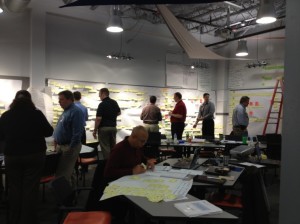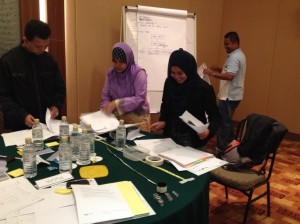Editor's Note: Take a look at our featured best practice, Motivating Your Workforce (51-slide PowerPoint presentation). It's no secret that employees who feel they are valued and recognized for the work they do are more motivated, responsible, and productive. This power point presentation will help supervisors and managers deliver training that will result in a more dynamic, loyal, and energized workplace. It is [read more]
How to Get your Employees Engaged
Also, if you are interested in becoming an expert on Human Resource Management (HRM), take a look at Flevy's Human Resource Management (HRM) Frameworks offering here. This is a curated collection of best practice frameworks based on the thought leadership of leading consulting firms, academics, and recognized subject matter experts. By learning and applying these concepts, you can you stay ahead of the curve. Full details here.
* * * *
Employee engagement creates a powerful, positive force for change. It helps break down departmental silos. It leads to increased operational effectiveness and fosters an environment where innovations are more likely to happen.
There are many benefits for organizations to have engaged employees: reduced turnover; which is a significant cost to organizations, enhanced commitment to business development and employee support towards achievement of business goals. But how do we achieve this? How do we get our employees involved?
According to SHRM (Society of Human Resource Management) the cost of replacing an employee is estimated to be about 75% of the base salary of the replaced employee so it’s well worth the effort to retain employees. Engaging employees is one way of doing this. Engaged employees “want” to help the organization realize its strategic imperatives. They strive to manage their work and their projects more effectively and efficiently and are more likely to focus on both the customer and organizational requirements. They demonstrate motivation and a high degree of morale and these behaviours set a fine example for other employees. Engaged employees also work effectively with other employees within their own group and often, between different groups and departments. This of course leads to faster results and increases the likelihood that the results of the efforts will be successfully implemented.
What is an Engaged Employee?
Wikipedia defines an “engaged employee” as “an employee who is fully involved in, and enthusiastic about their work, and thus will act in a way that furthers their organization’s interests.” According to Scarlett Surveys, “Employee Engagement is a measurable degree of an employee’s positive or negative emotional attachment to their job, colleagues and organization that profoundly influences their willingness to learn and perform at work”.
There is no doubt that engaged employees will be less likely to leave an organization. That being said, the US Conference Board’s 2012 research indicated that fewer than half of U.S. workers are satisfied with their jobs. Clearly these “dissatisfied employees” are not engaged employees.
The Gallup Management Journal publishes a semi-annual Employment Engagement Index. The most recent U.S. results are startling and indicate that:
- Only 29 percent of employees are actively engaged in their jobs. These employees work with passion and feel a profound connection to their company. People that are actively engaged help move the organization forward.
- Fifty-four percent of employees are not engaged. These employees have essentially “checked out,” sleepwalking through their workday and putting time – but not passion – into their work. These people embody what Jack Welch said several years ago. To paraphrase him: “Never mistake activity for accomplishment.”
- Seventeen percent of employees are actively disengaged. These employees are busy acting out their unhappiness, undermining what their engaged co-workers are trying to accomplish.
Ways to Engage Employees
So how can we get our employees involved? There are various ways to make this happen. Here are some real-life examples of ways some of our clients have successfully engaged their employees.
Engagement through Teamwork
One way is to take measures that motivate employees to work collaboratively rather than independently. I recently worked in Malaysia and one of the managers I worked with, Raj, shared a story about how his extreme approach to getting employees engaged by working as a team had worked successfully.
Raj’s organization hires a lot of technical employees and there is usually a high level of turnover among them. Through his recruitment interviews over the years, Raj learned that, in most cases, technical skill employees preferred to work alone and independently and they didn’t enjoy working collaboratively. Yet to be successful, Raj believed that his organization required employees to work collaboratively and in teams, to achieve the organization’s goals.
So shortly after they started, Raj gave this group of technical employees a small project and told them to work as a team to complete it. Moreover, he warned that if any individual were to fail in delivering the project successfully that he would fire all of them. They were perplexed. Why would the performance of one affect them all? It wasn’t fair. However, despite their objections, Raj enforced his rule and told them that he knew they could figure out how to get this project managed and implemented over the next month.
After a month passed and the project completed, it was time for Raj to review their performance. Although they didn’t all succeed, he told them that he had decided not to fire any of them. Of course, they were relieved. He then gave them another project with the same parameters; they all had to succeed. If any one of them didn’t, he’d fire them all. Eventually this group of four technical, independent-minded employees learned how to work collaboratively; supporting and assisting each other whenever required. It’s now been 5 years and they are working more effectively as a team than independently, supporting and helping each other more than any other group in the organization.
Some of you reading read this story may discredit it, believing that this can’t be—employees need parameters and any threat of discharge will probably backfire. So I give you this quote to consider from Nobel-winning psychologist Daniel Kahneman and author of the book, “2012 Thinking, Fast and Slow.” He says, “The confidence people have in their beliefs is not a measure of quality of evidence but of the coherence of the story the mind has managed to construct.”
Engagement through Project Management
This is a story about a new product launch that was in a complete crisis. The project was months over schedule and millions of dollars over budget. If it failed, there could be very serious consequences to the organization.
Business Improvement Architects was called in to audit the project and then help the organization to implement our recommendations. Of the many areas we uncovered that had led to this organization’s project management crisis, one of the major issues was a complete lack of employee engagement. Most departments worked independently including: engineering, product design, sales, manufacturing, IT and marketing. Furthermore, prior efforts to get them to work co-operatively had failed. Moreover, the employees didn’t even work effectively in their own departments; so it’s no wonder that they couldn’t work collaboratively between departments.
Because we were being asked to help this client with the implementation of our recommendations, the product had to launch on time or there would be serious consequences to the organization. To get this achieved, we focussed on employee engagement. We worked with the key program management team and their extended team members as a team to plan our approach.
The first objective was to set in place agreement as to:
- The team’s roles and responsibilities
- Establishment of rules that would govern how they could work effectively with each other,
- A process for on-going team self-evaluation
We followed this with time spent, as a team, to re-define the program scope and create the detailed program plan.

Engagement though Process Management
This is a story about an organization that operated with many departments, each working in individual silos. They would discuss issues, concerns and challenges with each other only when required. Resolution of these issues was always a long, laborious process. This siloed approach to work was ingrained in their culture. Most employees said they continued to work there for the money but if something else came along, they’d be out of there.
When our company was brought in to help them “improve processes” we quickly identified how their current culture had constrained their ability to realize operational effectiveness and how it was negatively impacting both their internal and external customers.

It has now been 6 months since our work with this customer. Our most recent review with the organization was incredibly positive. Their employees are now feeling much more engaged and positive. The comments we are hearing from them are: “Wow”, “I can’t believe that we are actually communicating so often” and ‘I really like working here now.”
Engage your Employees
Practitioners and academics have argued that an engaged workforce can create competitive advantage. They say that it’s imperative for leaders to identify the level of engagement in their organization and to implement strategies that will facilitate it.
In our experience there are many ways to engage your employees. While it is the unique elements of the work experience that tend to influence engagement, all begin with a conscious effort to encourage collaboration and team work.
Employee engagement creates a powerful, positive force for change. It helps to break down silos. It leads to increased operational effectiveness and fosters an environment where innovations are more likely to happen.

Want to Achieve Excellence in Human Resource Management (HRM)?
Gain the knowledge and develop the expertise to become an expert in Human Resource Management (HRM). Our frameworks are based on the thought leadership of leading consulting firms, academics, and recognized subject matter experts. Click here for full details.
The purpose of Human Resources (HR) is to ensure our organization achieves success through our people. Without the right people in place—at all levels of the organization—we will never be able to execute our Strategy effectively.
This begs the question: Does your organization view HR as a support function or a strategic one? Research shows leading organizations leverage HR as a strategic function, one that both supports and drives the organization's Strategy. In fact, having strong HRM capabilities is a source of Competitive Advantage.
This has never been more true than right now in the Digital Age, as organizations must compete for specialized talent to drive forward their Digital Transformation Strategies. Beyond just hiring and selection, HR also plays the critical role in retaining talent—by keeping people engaged, motivated, and happy.
Learn about our Human Resource Management (HRM) Best Practice Frameworks here.
Readers of This Article Are Interested in These Resources

|
|
21-slide PowerPoint presentation
|
|
25-slide PowerPoint presentation
| |||
About Michael Stanleigh
Michael Stanleigh, CMC, CSP is the CEO of Business Improvement Architects. He works with leaders and their teams around the world to improve organizational performance by helping to define their strategic direction, increase leadership performance, create cultures that drive innovation and improve project and quality management. He has been instrumental in helping his clients increase productivity and profits with his innovative approaches and focus on quality. For more information about this article, please contact him at mstanleigh@bia.ca or phone, 416-444-8225.
Top 10 Recommended Documents on Employee Engagement
» View more resources Employee Engagement here.
» View the Top 100 Best Practices on Flevy.













